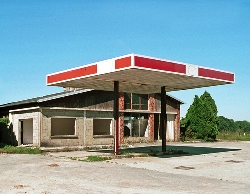
New Europe-wide study reveals potential for environmental impact from filling stations. Sarah Day reports.
Geoscientist Online 16 August 2011
The first Europe-wide, peer reviewed survey of retail filling station locations reveals that, while most are not in sensitive locations, more than one in ten are located in areas of high environmental sensitivity.
- Image: No longer an environmental threat? Most working service stations in Europe pose little or no serious threat to the environment. However, 14% were found to be sited in areas of high sensitivity.Photo © Eric Tabuchi.
The study, published in the current
Quarterly Journal of Engineering Geology and Hydrogeology1, surveyed nearly 86,000 retail filling station sites across Europe, using five categories of sensitivity. The study was funded by CONCAWE
2 (CONservation of Clean Air and Water in Europe), an environmental research organisation supported by oil companies.
Sites were assessed for their proximity to surface water, groundwater and ecologically sensitive areas, and researchers found that although the vast majority fell within the lowest sensitivity categories, 14% were classified as category 1 or 2, the two highest sensitivity categories, for at least one type of environmental receptor considered.
“The results are consistent with the experience gained through CONCAWE member companies’ own asset management programmes, but this is the first time that all filling stations have been surveyed to such an extent and the results subject to peer review”, says Dr Jonathan Smith CGeol (Shell Global Solutions (UK)) , Chairman of the CONCAWE Soil and Groundwater Task Force.
“They show that the vast majority of stations are located in areas where they do not have the potential to cause harm, but there are a small number where investing in preventive measures would be advisable.” Areas with the highest concentration of high sensitivity sites include southern England, Italy, south-west Germany and southern Poland.
If fuel were to leak from a filling station, it has the potential to contaminate the environment, depending on whether there is a way for the leaked fuel to reach a receptor such as a groundwater aquifer, river or lake. The survey assessed only the proximity of stations to such receptors, without including information on the integrity of the station or its maintenance.
POTENTIAL
“The results show only where there is potential for significant environmental impact” says Smith. “Many sites in higher sensitivity locations, as well as lower sensitivity areas, already have comprehensive engineering controls and management systems in place to minimise the likelihood of a release.”
However, the results emphasise the importance of monitoring individual areas of concern, and investing in safety measures to prevent dangerous releases.
“The study shows that the industry is acting proactively and responsibly towards retail filling station safety and environmental protection”, says Smith. “Hopefully these results will help focus attention on those few stations which are in highly sensitive areas where a leak could cause more serious damage, and will encourage a site-specific approach to meeting the environmental goals of the EU Water Framework Directive.”
References cited
- K. Daines, R. Dow, G. Lethbridge, J.W.N. Smith, and K.H. den Haan An analysis of the environmental sensitivity of retail filling station locations across Europe Quarterly Journal of Engineering Geology and Hydrogeology August 2011, v. 44:307-319; doi:10.1144/1470-9236/10-058
- CONCAWE - www.concawe.be/Content/Default.asp?